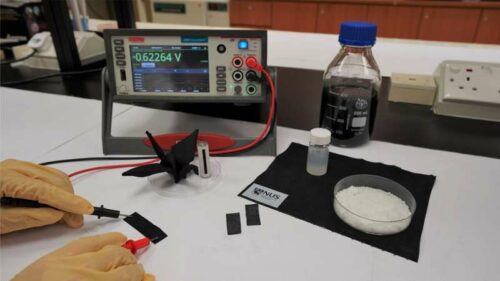Researchers from the National University of Singapore’s (NUS) College of Design and Engineering (CDE) developed an ultra-thin device to generate electricity from moisture present in the air

A team of researchers led by Assistant Professor Tan Swee Ching from the Department of Materials Science and Engineering under CDE invented a new technique of moisture-driven electricity generation (MEG) device that is capable of maintaining the difference in water content across the regions for the generation of electricity and continue to produce output for long hours.
The team utilized fabric made from a combination of wood pulp and polyester. The process is one part of the fabric is coated with hygroscopic ionic hydrogel and is also called a wet region. This gel is made from sea salt and can absorb more than six times its original weight and collect moisture from the air. The other part of the fabric is the dry region to ensure water is in the wet region only.
“Sea salt was chosen as the water-absorbing compound because of its non-toxic properties and its potential as a sustainable option for desalination plants to dispose of the resulting sea salt and brine,” shared Associate Professor Tan.
The MEG device assembled can generate electricity when sea salt ions separate as water is absorbed by a wet area. Carbon nanoparticles that consist of a negative charge will attract free ions with a positive charge. This process induces an electric charge onto the fabric and these surface changes give the fabric ability to store electricity for later use.
“Thanks to this unique asymmetric structure, the electrical performance of our MEG device is greatly improved compared to previous MEG technologies, making it possible to power many common electronic devices such as health monitors and wearable electronics,” explained Asst. Professor Tan.
The team demonstrated the flexible properties of the device by twisting it into an origami crane and not affecting its electrical performance. Its unique wet-dry region design maintains high water content in the wet region and low water content in the dry region. This is tested by researchers by exposing the device to an outdoor humid environment for 30 days but the fabric still retained water showing the efficiency of the device to maintain electrical power.
Click for the published Research Paper and Video.






